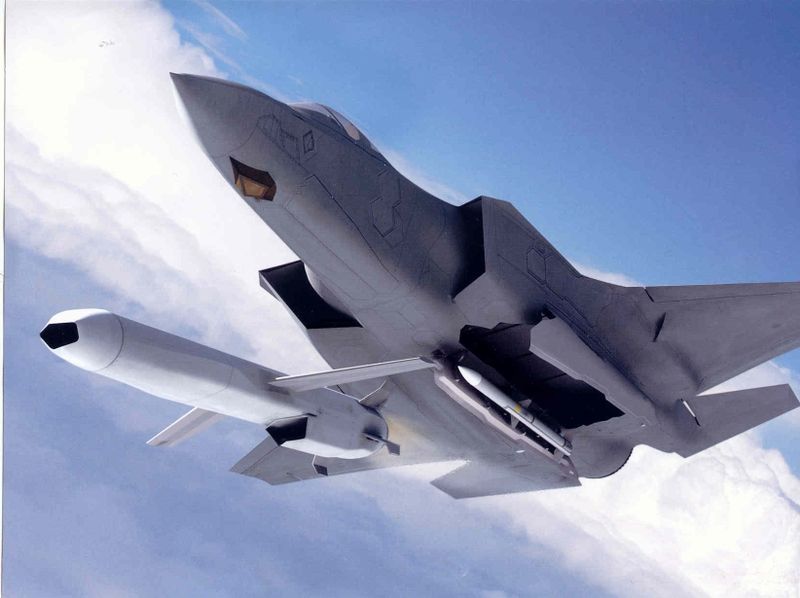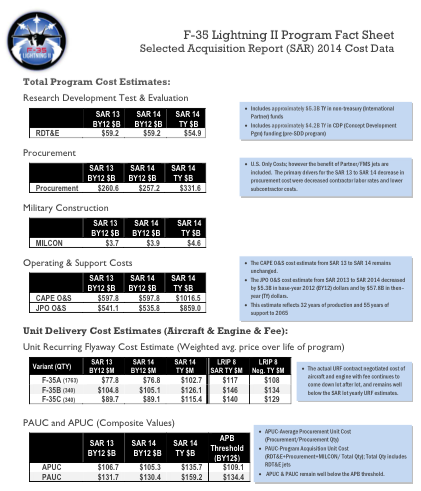DoD Acquisition Starting To Turn Corner? F-35 Costs Down 2%
Posted on
UPDATED: JSF JPO Details Each Variant Costs; Provides Other Details
PENTAGON: The simple lead for this story would be: F-35 costs dropped almost 2 percent over the last year.
But the real lead should be: after decades of botched programs, bloated budgets, technical screwups and long delays we may be seeing what Winston Churchill might have called the beginning of the beginning of the end of acquisition malfeasance by America’s military. The 79 major programs monitored for the Pentagon’s authoritative Selected Acquisition Report dropped $9.1 billion from last year.
The F-35 comprises 20 percent of the SAR portfolio, so its $7.5 billion (1.9 percent) price decrease from last year is an important driver behind the overall drop. Inflation and lower labor costs drove most of the decrease. (Readers can scroll down to see the prices for each variant of the F-35.)
“We are extremely pleased with the nearly $60 billion decrease in Operations and Support costs of the F-35 program during the last year alone,” Lorraine Martin, Lockheed’s F-35 general manager, said in a statement. “This is a result of a laser focus by the entire government and contractor team on reducing costs across the board whether it’s improving quality in manufacturing, increasing supply chain delivery speed, and dramatically reducing concurrency items.”
Here is the official explanation for the overall decline from the authoritative Selected Acquisition Report for 2014:
This cost decrease is due primarily to the application of lower escalation rates (-$10,795.2 million) and reductions in support requirements (-$9,000.5 million). These decreases were partially offset by a net increase in the cost of planned quantities to be purchased (+$2,487.2), a net stretch-out of development and procurement schedules (+$2,383.7 million), engineering changes to hardware/software (+$5,432.9 million), a net increase in program cost estimates (+$158.5 million), and an increase in other costs due to prior year impacts to the LPD 17 San Antonio Class Amphibious Transport Dock (+$214.5 million).
I can’t tell you who said it, but a senior Pentagon official replied this way when I asked yesterday if Pentagon acquisition was turning the corner: “I believe it is. I’m an optimistic person.” The official backed off a bit under questioning by colleagues, conceding that it would take two or three years of proven results to demonstrate the corner really has been turned. That’s entirely reasonable, but the fact remains that change is, at least and at last, in the air.
As only Breaking Defense readers know, the Air Force has actually brought down its costs for the last two years, so there are other indicators that this trend is not isolated.
There were several mentions of Frank Kendall’s various versions of Better Buying Power as reasons for the improvement, but the one specific factor that the senior official clearly believed was helping get things back on track (were they ever on track?):
Asking the services to do that affordability analyses: that is making a big difference,” the senior official said. “They are being done consistently over time, and that is making a difference.”
A second Pentagon official took a harder, broader line: “There is no silver bullet. There is a lot of work to get these things lined up right.”
Now, part of the reason for the SAR decline is inflation, or the lack thereof. As the SAR report notes, the single biggest decline was in the cost of inflation: $10.8 billion. Before everyone starts screaming that this proves they have rigged the system, please remember that the Department of Defense must use the inflation estimate provided by the White House’s Office of Management and Budget (OMB), as do all government agencies.
Perhaps the most troubling increase comes from the seemingly perennially screwed up WIN-T program. The latest problem is with Increment 2 of the program, which will allow company-level elements to receive satellite data while they are on the move. It’s the only Nunn-McCurdy breach of a continuing program in this SAR. Now this breach isn’t the result of technical problems, but does appear reflective of the Army’s continuing struggle to figure out what to buy and when to buy it. Much of the latest increase comes, the SAR says. from a “a quantity reduction of 1,684 nodes from 5,267 to 3,583, and an eight-year extension of the procurement schedule to align with the revised Army modernization strategy, which transfers total requirements to WIN-T Inc 2 from WIN-T Inc 3.”
I’ll leave it to our readers to comb through the other details of the SAR. Just click on the link in the first sentence, or here.
Here are a few more details about the F-35 costs. For those who wonder why there isn’t a new operations estimate, here’s the JPO explanation.
“By policy, the Director, Cost Assessment and Program Evaluation (CAPE) which authors the SAR does not update program Operating & Support (O&S) cost numbers until a major program milestone is reached. For that reason, the official SAR O&S numbers repeat last year’s figure – so there was no change.”
The JPO provided its own revised figure: $859 billion.
Finally, the F-35A version comes in at $108 million (with engine) for LRIP 8. That is $4 million lower than lot 7. prices.
Subscribe to our newsletter
Promotions, new products and sales. Directly to your inbox.


